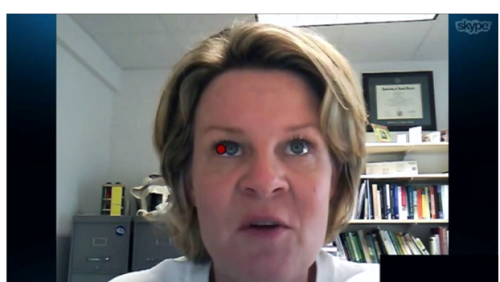Innovative use of eye-tracker technology shows children with autism fixating more on the mouth than the eyes during emotional conversations.
University of Vermont - Where do your eyes focus during a conversation? An innovative study by University of Vermont researchers reveals that for children with autism spectrum disorder, the answer depends on how emotional the conversation is.
The study, published in Research in Autism Spectrum Disorders, shows that children with the developmental disability fixate longer on a speaker's mouth rather than the eyes when the conversation turns emotional. It's the first study of its kind to use eye tracker technology to monitor eye movement during an interactive conversation, and the results could affect the way speech therapists treat the estimated 1 in 68 children who struggle with the social, communication and behavioral challenges caused by autism spectrum disorder (ASD).
See how Professor Tiffany Hutchins used the eye-tracking technology during conversations with typically developing children and children with autism spectrum disorder. Credit: University of Vermont. (Click on image to launch video)
Using the Mirametrix S2 Eye Tracker system and Skype, the researchers compared the visual attention of typically developing children and children with ASD during a conversation about mundane topics, like what people do when they get up in the morning. Then, the conversation turned to emotions, like what makes the child sad or scared.
"What you talk about really matters for children with ASD," says lead author Tiffany Hutchins, assistant professor of communication sciences and disorders. "You just change a few words by talking about what people do versus how they feel and you can have a profound impact on where eyes go for information."
Hutchins' study also shows that a shift away from the eyes towards the mouth by children with ASD was associated with higher autism severity, more limited executive function, and poorer verbal and intellectual ability.
Although it is unclear why children with ASD look at mouths more frequently during emotional conversations, Hutchins theorizes that talking about emotions strains executive function. Emotionally charged topics "likely place high demand on working memory, which, when a threshold is surpassed, makes rendering information from the eye region particularly difficult," she says.
Consequently, the child with ASD may start searching elsewhere for more accessible information.
Talking about emotions is really hard and very draining for children with ASD," says Hutchins. "It's like driving in a snowstorm. Normally, when you drive around in good weather on a familiar route, you go on automatic pilot and sometimes don't even remember how you got somewhere. But for a child with ASD, having a conversation, especially one about emotions, is more like driving in a snowstorm. In that situation, you are totally focused, every move is tense and effortful, and your executive function drains away. In fact, we found that decreased working memory correlated with decreased eye fixations, so as working memory decreases, then we see fewer fixations on the eyes."
Hutchins' findings are also significant because eye information may be more relevant in conversations about emotions. As a result, children with ASD miss the chance to understand the relationship between facial expressions and underlying thoughts because they neglect the abundance of social meaning given in the eyes, she says.
"It's probably a situation where the poor are getting poorer," Hutchins says. "If I'm asking you to talk about emotions, and that makes you even less likely to look in my eyes when you really need to go there because I'm more likely to be showing other evidence of an emotion like anger with my eyebrows, you are missing even more. It's not that there's no emotional information in the mouth, but during dynamic conversational exchanges they are missing a number of cues that a typically developing child would not."
Participants in the study included 19 typically developing children and 18 children diagnosed with ASD between the ages of six and 12 years of age. During conversations recorded via Skype, the tracking system, using infrared light bounching off the retinas, recorded X and Y coordinates of eye positions.
We were amazed that no one had done this yet," Hutchins says. "We found only two other studies that used eye tracking to look at social attention during actual conversations with other people, but none with autism. Combining Skype with basic eye-tracking technology feels like low-hanging fruit, and it circumvents a lot of the traditional challenges that we've had in the field so when that catches on, I think the implications are that you can do a lot with this technology. I think being first is one of our major contributions."
Hutchins says past studies have relied on social observation in videos or static pictures of people's faces with different emotions, which didn't require children with ASD to engage with someone in an interactive conversation. "When a child with ASD engages with me, they don't just watch me passively, they have to monitor my engagement, think about what I'm doing, my tone, and my affect to get my full meaning, and that's really different than passively observing something," she says.
Hutchins' co-author, Ashley Brien, a UVM graduate student at the time of the study, is now a speech pathologist at a school district in northern Vermont. The pair are now considering how the study affects the way speech pathologists work with students with ASD. For example, they say therapists should think about the consequences of telling a child with autism to look intently into their eyes.
"Some social skills programs and many treatment goals for children with autism involve trying to get them to initiate and sustain eye-contact during interaction" says Hutchins. Brien adds that the consequences of these practices, like increased anxiety, could be counterproductive. As Brien says, "some of the interventions that are used are not time tested or evidence based, but we're hoping to change that."
Source: https://www.eurekalert.org/pub_releases/2016-04/uov-nsa040416.php


